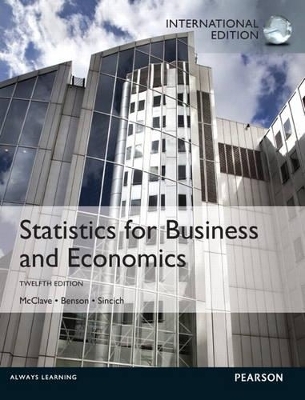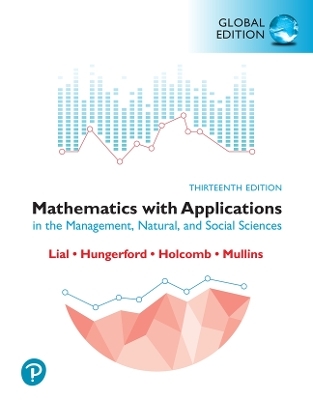
Statistics for Business and Economics
Pearson
978-0-321-86682-0 (ISBN)
- Titel erscheint in neuer Auflage
- Artikel merken
The Twelfth Edition has been updated with real, current data in many of the exercises, examples, and applications. Exercises draw on actual business situations and recent economic events so that students can test their knowledge throughout the course. Statistics in Action case studies open each chapter with a recent, controversial, or high-profile business issue, motivating students to critically evaluate the findings and think through the statistical issues involved. A continued emphasis on ethics highlights the importance of ethical behavior in collecting, interpreting, and reporting on data.
Dr. Jim McClave is currently President and CEO of Info Tech, Inc., a statistical consulting and software development firm with an international clientele. He is an Adjunct Professor of Statistics at the University of Florida, where he was a full-time member of the faculty for 20 years. P. George Benson is the 21st president of the College of Charleston. Prior to his appointment, he was Dean at the University of Georgia’s C. Herman and Mary Virginia Terry College of Business. His research interests include quality management, strategic management, belief formation, and judgmental forecasting. He consults nationally in the areas of applied statistics, quality management, and employment discrimination. Terry Sincich obtained his PhD in statistics from the University of Florida in 1980. He is an Associate Professor in the Information Systems & Decision Sciences Department at the University of South Florida in Tampa. Dr. Sincich is responsible for teaching basic statistics to all undergraduates in the College of Business, as well as advanced statistics to all business doctoral candidates. He has published articles in such journals as the Journal of the American Statistical Association, International Journal of Forecasting, Academy of Management Journal, and Auditing: A Journal of Practice & Theory. Dr. Sincich is a co-author of the texts Statistics, A First Course in Statistics, Statistics for Engineering & the Sciences, and A Second Course in Statistics: Regression Analysis.
1. Statistics, Data, and Statistical Thinking
1.1 The Science of Statistics
1.2 Types of Statistical Applications in Business
1.3 Fundamental Elements of Statistics
1.4 Processes (Optional)
1.5 Types of Data
1.6 Collecting Data: Sampling and Related Issues
1.7 Critical Thinking with Statistics
Statistics in Action: A 20/20 View of Surveys: Fact or Fiction?
Activity 1.1: Keep the Change: Collecting Data
Activity 2.2: Identifying Misleading Statistics
Using Technology: Accessing and Listing Data; Random Sampling
2. Methods for Describing Sets of Data
2.1 Describing Qualitative Data
2.2 Graphical Methods for Describing Quantitative Data
2.3 Numerical Measures of Central Tendency
2.4 Numerical Measures of Variability
2.5 Using the Mean and Standard Deviation to Describe Data
2.6 Numerical Measures of Relative Standing
2.7 Methods for Detecting Outliers: Box Plots and z-Scores
2.8 Graphing Bivariate Relationships (Optional)
2.9 The Time Series Plot (Optional)
2.10 Distorting the Truth with Descriptive Techniques
Statistics in Action: Can Money Buy Love?
Activity 2.1: Real Estate Sales
Activity 2.2: Keep the Change: Measures of Central Tendency and Variability
Using Technology: Describing Data
Making Business Decisions: The Kentucky Milk CasePart 1 (Covers Chapters 1 and 2)
3. Probability
3.1 Events, Sample Spaces, and Probability
3.2 Unions and Intersections
3.3 Complementary Events
3.4 The Additive Rule and Mutually Exclusive Events
3.5 Conditional Probability
3.6 The Multiplicative Rule and Independent Events
3.7 Bayes’s Rule
Statistics in Action: Lotto Buster!
Activity 3.1: Exit Polls: Conditional Probability
Activity 3.2: Keep the Change: Independent Events
Using Technology: Combinations and Permutations
4. Random Variables and Probability Distributions
4.1 Two Types of Random Variables
PART I: Discrete Random Variables
4.2 Probability Distributions for Discrete Random Variables
4.3 The Binomial Distribution
4.4 Other Discrete Distributions: Poisson and Hypergeometric
PART II: Continuous Random Variables
4.5 Probability Distributions for Continuous Random Variables
4.6 The Normal Distribution
4.7 Descriptive Methods for Assessing Normality
4.8 Other Continuous Distributions: Uniform and Exponential
Statistics in Action: Probability in a Reverse Cocaine Sting: Was Cocaine Really Sold?
Activity 4.1: Warehouse Club Memberships: Exploring a Binomial Random Variable
Activity 4.2: Identifying the Type of Probability Distribution
Using Technology: Discrete Probabilities, Continuous Probabilities, and Normal Probability Plots
5. Sampling Distributions
5.1 The Concept of a Sampling Distribution
5.2 Properties of Sampling Distributions: Unbiasedness and Minimum Variance
5.3 The Sampling Distribution of the Sample Mean and the Central Limit Theorem
5.4 The Sampling Distribution of the Sample Proportion
Statistics in Action: The Insomnia Pill: Is It Effective?
Activity 5.1: Simulating a Sampling DistributionCell Phone Usage
Using Technology: Simulating a Sampling Distribution
Making Business Decisions: The Furniture Fire Case (Covers Chapters 3–5)
6. Inferences Based on a Single Sample: Estimation with Confidence Intervals
6.1 Identifying and Estimating the Target Parameter
6.2 Confidence Interval for a Population Mean: Normal (z) Statistic
6.3 Confidence Interval for a Population Mean: Student’s t-Statistic
6.4 Large-Sample Confidence Interval for a Population Proportion
6.5 Determining the Sample Size
6.6 Finite Population Correction for Simple Random Sampling (Optional)
6.7 Confidence Interval for a Population Variance (Optional)
Inferences Based on a Single Sample: Estimation with Confidence Intervals
Statistics in Action: Medicare Fraud Investigations
Activity 6.1: Conducting a Pilot Study
Using Technology: Confidence Intervals
7. Inferences Based on a Single Sample: Tests of Hypotheses
7.1 The Elements of a Test of Hypothesis
7.2 Formulating Hypotheses and Setting Up the Rejection Region
7.3 Observed Significance Levels: p-Values
7.4 Test of Hypothesis about a Population Mean: Normal (z) Statistic
7.5 Test of Hypothesis about a Population Mean: Student’s t-Statistic
7.6 Large-Sample Test of Hypothesis about a Population Proportion
7.7 Test of Hypothesis about a Population Variance
7.8 Calculating Type II Error Probabilities: More about b (Optional)
Statistics in Action: Diary of a Kleenex® User—How Many Tissues in a Box?
Activity 7.1: Challenging a Company's Claim: Tests of Hypotheses
Activity 7.2: Keep the Change: Tests of Hypotheses
Using Technology: Tests of Hypotheses
8. Inferences Based on Two Samples: Confidence Intervals and Tests of Hypotheses
8.1 Identifying the Target Parameter
8.2 Comparing Two Population Means: Independent Sampling
8.3 Comparing Two Population Means: Paired Difference Experiments
8.4 Comparing Two Population Proportions: Independent Sampling
8.5 Determining the Required Sample Size
8.6 Comparing Two Population Variances: Independent Sampling
Statistics in Action: ZixIt Corp. v. Visa USA Inc.—A Libel Case
Activity 8.1: Box Office Receipts: Comparing Population Means
Activity 8.2: Keep the Change: Inferences Based on Two Samples
Using Technology: Two-Sample Inferences
Making Business Decisions: The Kentucky Milk Case—Part II (Covers Chapters 6–8)
9. Design of Experiments and Analysis of Variance
9.1 Elements of a Designed Experiment
9.2 The Completely Randomized Design: Single Factor
9.3 Multiple Comparisons of Means
9.4 The Randomized Block Design
9.5 Factorial Experiments: Two Factors
Statistics in Action: Pollutants at a Housing Development—A Case of Mishandling Small Samples
Activity 9.1: Designed vs. Observational Experiments
Using Technology: Analysis of Variance
10. Categorical Data Analysis
10.1 Categorical Data and the Multinomial Experiment
10.2 Testing Category Probabilities: One-Way Table
10.3 Testing Category Probabilities: Two-Way (Contingency) Table
10.4 A Word of Caution about Chi-Square Tests
Statistics in Action: The Case of the Ghoulish Transplant Tissue—Who Is Responsible for Paying Damages?
Activity 10.1: Binomial vs. Multinomial Experiments
Activity 10.2: Contingency Tables
Using Technology: Chi-Square Analyses
Making Business Decisions: Discrimination in the Workplace (Covers Chapters 9 and 10)
11. Simple Linear Regression
11.1 Probabilistic Models
11.2 Fitting the Model: The Least Squares Approach
11.3 Model Assumptions
11.4 Assessing the Utility of the Model: Making Inferences about the Slope b1
11.5 The Coefficients of Correlation and Determination
11.6 Using the Model for Estimation and Prediction
11.7 A Complete Example
Statistics in Action: Legal Advertising—Does It Pay?
Activity 11.1: Apply Simple Linear Regression to Your Favorite Data
Using Technology: Simple Linear Regression
12. Multiple Regression and Model Building
12.1 Multiple Regression Models
PART I: First-Order Models with Quantitative Independent Variables
12.2 Estimating and Making Inferences about the b Parameters
12.3 Evaluating Overall Model Utility
12.4 Using the Model for Estimation and Prediction
PART II: Model Building in Multiple Regression
12.5 Interaction Models
12.6 Quadratic and Other Higher-Order Models
12.7 Qualitative (Dummy) Variable Models
12.8 Models with Both Quantitative and Qualitative Variables
12.9 Comparing Nested Models
12.10 Stepwise Regression
PART III: Multiple Regression Diagnostics
12.11 Residual Analysis: Checking the Regression Assumptions
12.12 Some Pitfalls: Estimability, Multicollinearity, and Extrapolation
Statistics in Action: Bid Rigging in the Highway Construction Industry
Activity 12.1: Insurance Premiums: Collecting Data for Several Variables
Activity 12.2: Collecting Data and Fitting a Multiple Regression Model
Using Technology: Multiple Regression
Making Business Decisions: The Condo Sales Case (Covers Chapters 11 and 12)
13. Methods for Quality Improvement: Statistical Process Control (Available on CD)
13.1 Quality, Processes, and Systems
13.2 Statistical Control
13.3 The Logic of Control Charts
13.4 A Control Chart for Monitoring the Mean of a Process: The [x-bar]-Chart
13.5 A Control Chart for Monitoring the Variation of a Process: The R-Chart
13.6 A Control Chart for Monitoring the Proportion of Defectives Generated by a Process: The p-Chart
13.7 Diagnosing the Causes of Variation
13.8 Capability Analysis
Statistics in Action: Testing Jet Fuel Additive for Safety
Activity 13.1: Quality Control: Consistency
Using Technology: Control Charts
MAKING BUSINESS DECISIONS: The Gasket Manufacturing Case (Covers Chapter 13)
14. Time Series: Descriptive Analyses, Models, and Forecasting (Available on CD)
14.1 Descriptive Analysis: Index Numbers
14.2 Descriptive Analysis: Exponential Smoothing
14.3 Time Series Components
14.4 Forecasting: Exponential Smoothing
14.5 Forecasting Trends: Holt’s Method
14.6 Measuring Forecast Accuracy: MAD and RMSE
14.7 Forecasting Trends: Simple Linear Regression
14.8 Seasonal Regression Models
14.9 Autocorrelation and the Durbin-Watson Test
Statistics in Action: Forecasting the Monthly Sales of a New Cold Medicine
Activity 14.1: Time Series
Using Technology: Forecasting
15. Nonparametric Statistics (Available on CD)
15.1 Introduction: Distribution-Free Tests
15.2 Single Population Inferences
15.3 Comparing Two Populations: Independent Samples
15.4 Comparing Two Populations: Paired Difference Experiment
15.5 Comparing Three or More Populations: Completely Randomized Design
15.6 Comparing Three or More Populations: Randomized Block Design
15.7 Rank Correlation
Statistics in Action: How Vulnerable Are New Hampshire Wells to Groundwater Contamination?
Activity 15.1: Keep the Change: Nonparametric Statistics
Using Technology: Nonparametric Tests
Making Business Decisions: Detecting “Sales Chasing” (Covers Chapters 10 and 15)
Appendix A: Summation Notation
Appendix B: Basic Counting Rules
Appendix C: Calculation Formulas for Analysis of Variance
C.1 Formulas for the Calculations in the Completely Randomized Design
C.2 Formulas for the Calculations in the Randomized Block Design
C.3 Formulas for the Calculations for a Two-Factor Factorial Experiment
C.4 Tukey's Multiple Comparisons Procedure (Equal Sample Sizes)
C.5 Bonferroni Multiple Comparisons Procedure (Pairwise Comparisons)
C.6 Scheffé's Multiple Comparisons Procedure (Pairwise Comparisons)
Appendix D: Tables
Table I. Binomial Probabilities
Table II. Normal Curve Areas
Table III. Critical Values of t
Table IV. Critical Values of x2
Table V. Percentage Points of the F-Distribution, α = .10
Table VI. Percentage Points of the F-Distribution, α = .05
Table VII. Percentage Points of the F-Distribution, α = .025
Table VIII. Percentage Points of the F-Distribution, α = .01
Table IX. Control Chart Constants
Table X. Critical Values for the Durbin-Watson d-Statistic, α = .05
Table XI. Critical Values for the Durbin-Watson d-Statistic, α = .01
Table XII. Critical Values of TL and Tu for the Wilcoxon Rank Sum Test: Independent Samples
Table XIII. Critical Values of T0 in the Wilcoxon Paired Difference Signed Rank Test
Table XIV. Critical Values of Spearman's Rank Correlation Coefficient
Table XV. Critical Values of the Studentized Range, α = .05
Answers to Selected Exercises
Index
Credits
| Sprache | englisch |
|---|---|
| Maße | 216 x 275 mm |
| Gewicht | 1510 g |
| Themenwelt | Mathematik / Informatik ► Mathematik ► Finanz- / Wirtschaftsmathematik |
| Mathematik / Informatik ► Mathematik ► Statistik | |
| ISBN-10 | 0-321-86682-7 / 0321866827 |
| ISBN-13 | 978-0-321-86682-0 / 9780321866820 |
| Zustand | Neuware |
| Haben Sie eine Frage zum Produkt? |
aus dem Bereich



